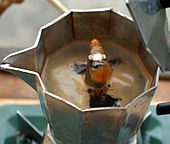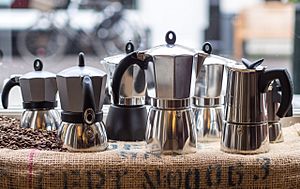Moka pot facts for kids
 |
|
| Manufacturer | Bialetti |
|---|---|
| Release date | 1933 |
The moka pot is a special kind of coffee maker. It sits on your stove or plugs into an outlet. This clever pot makes coffee by pushing hot water, powered by steam, through ground coffee. It's named after the city of Mocha in Yemen. An Italian engineer named Alfonso Bialetti invented it in 1933. Soon, it became a super important part of Italian culture. The company Bialetti Industries still makes the same classic model today, called "Moka Express."
From Italy, the moka pot became popular all over Europe and Latin America. It's so famous that it's seen as a cool design. You can even find it in modern art and design museums! These include the Museum of Modern Art and the London Science Museum.
Moka pots come in many sizes. They can make from one to eighteen small 50 ml (2 imp fl oz; 2 US fl oz) servings of coffee. The first designs and many new ones are made from aluminium. They usually have handles made of a plastic called Bakelite.
After the Second World War, the Italian moka pot spread across Southern Europe. It became the main way people made coffee at home. Because it was so popular, other companies outside Italy started making their own versions. They copied the original Italian design or made new ones inspired by it.
In Australia, Italian people who moved there after the Second World War often used moka pots. By the year 2000, many Australian homes had one. Today, it's quite popular for breakfast. Australians often add the coffee to a mug and top it with hot water or warm milk.
Most moka pots are made of aluminium. But sometimes, you can find them made from stainless steel or other metal mixes.
Contents
How a Moka Pot Makes Coffee
You use moka pots on a stove, either gas or electric. If you have an induction stove, you'll need a stainless steel moka pot, as aluminium ones won't work.
Using a moka pot is pretty simple for everyday coffee. But scientists have studied how it works! They found that the water doesn't need to boil to make coffee. The steam pressure and expanding air are enough. They also found that using water that's already warm (around 70°C) can make the best coffee.
Here's how you use it:
- First, fill the bottom part (marked A in the picture) with water. Don't fill it past the safety valve.
- Next, put the funnel-shaped metal filter (B) into the bottom part.
- Add finely ground coffee to this filter. How tightly you pack the coffee changes how fast the coffee brews.
- Then, screw the top part (C) onto the bottom. A rubber seal makes sure it's tightly closed. This helps pressure build up safely. There's also a safety valve in case the pressure gets too high.
- Finally, put the pot on your stove.
As the water in the bottom heats up, pressure builds. This pressure pushes the water up through the funnel and through the coffee grounds. Fresh coffee then flows into the top chamber (C).
When the bottom part is almost empty, you'll hear a gurgling sound. This means steam and hot water are mixing. When you hear this, it's time to take the pot off the stove! If you let it keep going, the coffee might taste bitter.
Adding more water to the bottom part doesn't mean you'll get more coffee. In fact, it can reduce how much coffee you get. The best amount of water is usually just below the safety valve.
Taking Care of Your Moka Pot
Moka pots need a little care to keep working well.
- You'll need to change the rubber seal and the filters every now and then.
- Always check that the safety release valve isn't blocked.
- When you get a new rubber seal, the coffee might taste a bit different at first. You can brew a couple of times without coffee, or with used grounds, to "break it in."
- Some people think leaving old coffee stains in the pot is good, but that's not true! You should always clean out old, stale coffee from all parts of the pot.
- Moka pots are usually not safe for dishwashers. Washing them in a dishwasher can damage the aluminium. It can make the pot look dirty and even cause more aluminium to get into your coffee. It's best to wash them by hand with a mild soap.
Moka Pot Sizes
Moka pots come in different sizes. The size is usually based on how many small 50 ml (2 imp fl oz; 2 US fl oz) "espresso" cups they can make. Here are the standard sizes for the Bialetti "Moka Express" model:
| Espresso cups |
Metric units | US units | ||||
|---|---|---|---|---|---|---|
| Volume (ml) | height (mm) | base (mm) | Volume (US fl oz) | height (in) | base (in) | |
| 1 | 60 | 133 | 64 | 2 | 5+1⁄4 | 2+1⁄2 |
| 3 | 200 | 159 | 83 | 6+1⁄2 | 6+1⁄4 | 3+1⁄4 |
| 6 | 300 | 216 | 102 | 10 | 8+1⁄2 | 4 |
| 9 | 550 | 254 | 105 | 18+1⁄2 | 10 | 4+1⁄8 |
| 12 | 775 | 292 | 127 | 25 | 11+1⁄2 | 5 |
What Moka Coffee Tastes Like
The taste of coffee from a moka pot can change a lot. It depends on:
- The type of coffee beans you use.
- How dark the beans are roasted.
- How finely you grind the coffee.
- The type of water you use.
- How much heat you use when brewing.
Some people call moka pots "stove-top espresso makers." The coffee they make is quite strong, a bit like espresso. However, real espresso machines use much higher pressure (about 9 bar). Moka pots use lower pressure (1 to 2 bar). So, moka coffee is not exactly the same as espresso. It has its own unique flavor!
Different Kinds of Moka Pots
Some companies have made changes to the classic moka pot design.
- One type has a special valve on top. This valve helps pressure build up faster inside the pot. This makes the coffee brew at a higher pressure and temperature. The result is coffee that's even more like espresso, sometimes with a bit of "crema" (the foamy layer on top).
- Another cool design lets you froth milk and mix it with the coffee while it's brewing!
See also
 In Spanish: Cafetera moka para niños
In Spanish: Cafetera moka para niños







